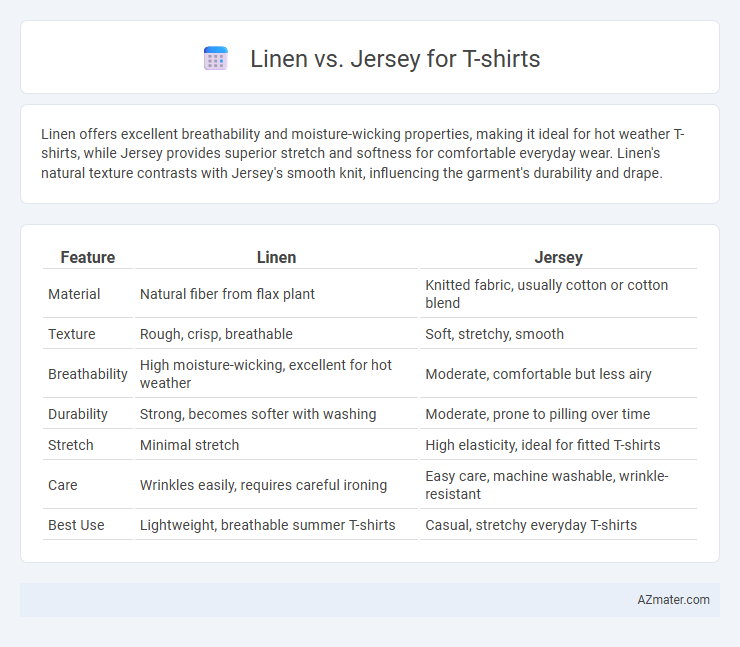Linen offers excellent breathability and moisture-wicking properties, making it ideal for hot weather T-shirts, while Jersey provides superior stretch and softness for comfortable everyday wear. Linen's natural texture contrasts with Jersey's smooth knit, influencing the garment's durability and drape.
Table of Comparison
| Feature | Linen | Jersey |
|---|---|---|
| Material | Natural fiber from flax plant | Knitted fabric, usually cotton or cotton blend |
| Texture | Rough, crisp, breathable | Soft, stretchy, smooth |
| Breathability | High moisture-wicking, excellent for hot weather | Moderate, comfortable but less airy |
| Durability | Strong, becomes softer with washing | Moderate, prone to pilling over time |
| Stretch | Minimal stretch | High elasticity, ideal for fitted T-shirts |
| Care | Wrinkles easily, requires careful ironing | Easy care, machine washable, wrinkle-resistant |
| Best Use | Lightweight, breathable summer T-shirts | Casual, stretchy everyday T-shirts |
Introduction: Linen vs Jersey for T-Shirts
Linen and jersey fabrics offer distinct qualities for T-shirts, with linen known for its breathability and natural texture, making it ideal for hot weather. Jersey fabric provides superior stretch and softness, often blending cotton or synthetic fibers for comfort and durability. Choosing between linen and jersey depends on desired wearability, climate comfort, and fabric performance in casual apparel.
Fabric Origins and Composition
Linen, derived from the flax plant, is a natural cellulosic fiber known for its breathability and durability, making it ideal for lightweight T-shirts in warm climates. Jersey fabric, commonly made from cotton or cotton blends, offers a soft, stretchy knit texture that enhances comfort and fit. The distinct origins--plant-based flax for linen and knitted cotton fibers for jersey--directly influence each fabric's moisture-wicking properties and tactile experience.
Texture and Feel on the Skin
Linen T-shirts offer a crisp, breathable texture that feels cool and slightly coarse against the skin, making them ideal for hot weather. Jersey fabric provides a soft, smooth, and stretchy feel due to its knit construction, enhancing comfort and flexibility for everyday wear. The choice between linen's natural firmness and jersey's gentle suppleness significantly impacts the tactile experience and moisture-wicking properties.
Breathability and Climate Suitability
Linen offers exceptional breathability due to its natural fiber structure, making it ideal for hot and humid climates by allowing air to flow freely and wick moisture away from the skin. Jersey, typically made from cotton or synthetic blends, provides a softer feel and moderate breathability, suitable for mild to warm weather but less effective in intense heat compared to linen. Choosing linen is optimal for thermal comfort in tropical environments, while jersey balances comfort and versatility across varying temperate conditions.
Durability and Longevity
Linen T-shirts are renowned for their exceptional durability, as the natural flax fibers resist wear and tear while becoming softer with each wash, ensuring long-lasting comfort. Jersey fabric, made from knit cotton or blends, offers excellent stretch and flexibility but tends to be less durable over time, often showing signs of pilling and thinning with frequent use. For longevity, linen outperforms jersey by maintaining structural integrity and breathability, making it ideal for T-shirts meant to endure regular wear and washing.
Moisture Absorption and Quick Drying
Linen exhibits superior moisture absorption due to its natural flax fibers, allowing sweat to evaporate quickly and keeping the wearer dry and comfortable. Jersey fabric, typically made from cotton or synthetic blends, absorbs moisture moderately but excels in quick drying thanks to its lightweight and knit structure. For T-shirts prioritizing moisture management, linen offers enhanced breathability and rapid sweat absorption, while jersey provides faster drying times for active wear.
Weight and Drape Characteristics
Linen T-shirts are generally heavier with a coarse weave, offering a stiff drape that maintains shape but limits fluidity. Jersey fabric, lightweight and softer, features a knit construction that provides a flexible and flowing drape, enhancing comfort and ease of movement. Weight differences influence breathability and garment structure, with linen ideal for structured, durable wear and jersey preferred for lightweight, casual fits.
Care and Maintenance Requirements
Linen T-shirts require gentle washing in cold water and air drying to maintain their natural fibers and avoid shrinkage, with ironing often needed to smooth wrinkles, whereas Jersey T-shirts made from cotton or synthetic blends are more durable, machine washable, and wrinkle-resistant, allowing for easier care and faster drying. Linen's breathable fabric demands more delicate handling to prevent damage, while Jersey's stretchy knit construction resists pilling and maintains shape with minimal maintenance. Choosing between linen and jersey depends on the balance of ease of care versus texture and breathability preferences.
Environmental Impact and Sustainability
Linen is made from flax plants requiring significantly less water and pesticides compared to the cotton used in jersey fabric production, resulting in a lower environmental footprint. Linen fibers are biodegradable and durable, enabling longer garment life and reducing landfill waste. Jersey, often cotton-based, generally consumes more water and chemicals during cultivation and processing, though organic and recycled jersey options improve its sustainability profile.
Best Uses and Style Recommendations
Linen T-shirts are ideal for hot weather due to their breathability and moisture-wicking properties, making them perfect for casual summer outings and beachwear. Jersey fabric offers a soft, stretchy, and comfortable fit suited for everyday wear and active lifestyles, often preferred for sporty or relaxed styles. For a polished yet effortless look, pair linen T-shirts with tailored shorts or chinos, while jersey T-shirts work well with jeans or joggers for a laid-back, versatile wardrobe staple.

Infographic: Linen vs Jersey for T-shirt
 azmater.com
azmater.com